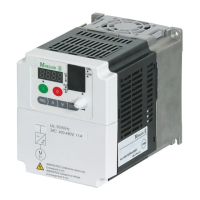Appendix
09/01 AWB8230-1412GB
118
Operation with fixed frequencies
Configuration of the parameters
Method of operation
Inputs 1 and 2 function exactly as described in the first example.
With the activation of one or both fixed frequency inputs FF1 and
FF2, the current frequency setpoint applied to the motor is
replaced by the fixed frequency determined by FF1 and FF2, and
the motor brakes or accelerates according to the fixed frequency
applied. If neither of the fixed frequency inputs FF1 and FF2 is acti-
vated, the frequency setpoint is determined through analog inputs
O (voltage setpoint value) or OI (current setpoint value). The
wiring for these terminals is not shown in this circuit example. For
the combination of the individual fixed frequency values, see
Section ”Fixed frequency FF1 to FF4 selection”, Page 56.
The circuit example also includes the parameter definition for one
output signal each on terminals 11 and 12. The type of output
signal is configured with PNU C21 for digital output 11 and with
C22 for digital output 12.
Figure 102: Fixed frequency definition
PNU Value
Function
A01 01 Setpoint value definition via control signal
terminal strip
A02 01
Start signal via FWD/REV terminals
F02 10
Acceleration time in s
F03 10
Deceleration time in s
C01 00
FWD: Start clockwise rotation on digital input 1
C02 01
REV: Start anticlockwise rotation on digital
input 2
C03 16
AT: Changeover to current setpoint value
(4 to 20 mA)
C04 02
FF1: Fixed frequency input 1
C05 03
FF2: Fixed frequency input 2
C21 00
RUN output signal on terminal 11
C22 01
FA1 output signal on terminal 12
A21 f
1
The fixed frequency which should be present
when FF1 is active and FF2 is inactive is entered
here.
A22 f
2
The fixed frequency which should be present
when FF1 is inactive and FF2 is active is entered
here.
A23 f
3
The fixed frequency which should be present
when FF1 and FF2 are both active is entered here.
+ 24 V
FA1
RUN
FF2
FF1
AT
REV
FWD
24 VH
P2412345
PES
11CM2 12

